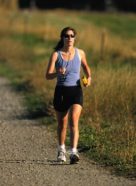Running with sneaker science
For marathon runners and other athletes, sneaker research helps reduce the pain.
By Emily Sohn
From that point on, the intense highs and lows of long-distance running consumed me. During some stretches, I thought I might just crumple to the ground. Then, inspired by the roaring crowd, my stride would suddenly feel strong and smooth. My body would become a machine, light as a feather.
 |
|
A Boston crowd watching the running of a marathon.
|
| Hans Kieserman |
The joy of completing my second marathon carried me across the finish line 3 hours, 40 minutes, and 16 seconds after I had begun. Agony immediately took over. I couldn’t walk properly for days.
All of the excitement over the New York City marathon, run 6 months after Boston on Nov. 2, inspired a new wave of marathon fever in me. I’ve already talked with a few friends about running it together next year. At the same time, I have mixed feelings about how much more my body can take. I just ran my third marathon a month ago. Now, I can’t run a step, due to a deeply cracked shin bone that is also keeping me from doing many of the other things I love, like climbing, biking, even walking and yoga.
A distance of 26.2 miles is just a long way to run, says Seth Kinley, an athletic trainer at Pennsylvania State University in University Park, Penn. “The bottom of your foot strikes the ground thousands of times.”
In labs across the country, researchers are using high-tech equipment to design new kinds of gear and improve training routines. By addressing nagging pains and other problems, sneaker science is helping athletes go faster, stronger, and longer.
Designing better gear
To combat the stresses inflicted by running and other sports, scientists study how the body moves. They then search for ways to help it move better.
Improvements often happen in baby steps. It can take as long as 2 years to turn an idea into a shoe that you can buy in a store, says Gordon Valiant, a biomechanist at Nike headquarters in Beaverton, Ore.
The process begins when an athlete or employee points out a specific need. Some athletes might want a shoe that prevents knee injuries. Others might wish to sprint faster or get a quicker start. Still others might want a shoe that works well on mountain trails.
Experiments come next. At the Nike Sports Research Lab in Beaverton, basketball courts, treadmills, and padded running platforms have sensors that measure the forces of impact. Wind tunnels and temperature-controlled chambers simulate real-world conditions. High-speed cameras take a thousand or more pictures per second. Computers perform analyses. Athletes come in to run and jump. A team of more than 25 experts watches their every move.
“We spend a lot of time in the lab measuring the different forces acting on the lower extremities and feet of athletes,” Valiant says. “That gives us insight into how we can either enhance or not interfere with the athlete’s motion, while at the same time protecting them from forces, or allowing them to use forces to their advantage. Knowledge of those things can really be applied to innovative designs.”
Adidas, New Balance, Reebok, and other companies conduct their own research, all with the same goal—to make better, faster, cooler-looking shoes. Of course, profits are important, too. Sneakers, as you may know, can cost a lot of money, and the market is extremely competitive. Research is also going on at universities, sometimes for commercial reasons, other times to help coaches and athletes train better, or simply for the scientific interest of the work.
Basic movements
The basic movement of a runner’s foot is fairly simple. The heel strikes the ground first, followed by a roll inward toward the toes. Then, the foot goes rigid, which allows the runner to launch forward, in a springboard kind of way. Any slight variation in that ideal running form can end up causing all sorts of injuries.
 |
|
Using the right sort of footwear—whether running a marathon or just jogging—can reduce the chances of suffering painful injuries.
|
“Pain in the knees, hips, and back can all stem from what’s going on in the foot,” says Kinley, who has worked with runners at Penn State for 10 years.
Everyone’s feet are different, though there are some general categories based on the shape of the arch. I have slightly flat feet, which makes my legs roll inward and throws my stride off kilter. I used to have severe knee pain as a result, until I started wearing stable shoes with lots of support.
Each shoe and piece of clothing is designed and tested to meet specific needs, Valiant says.
Marathon runners want lightweight footwear with plenty of cushioning, for example. Racing shoes for shorter distances often sacrifice cushioning for flexibility. Basketball shoes need to be sturdy enough to deal with lots of twisting and jumping.
Moreover, the best combination of shoe length and width varies from men to women to kids, and among people from different ethnic backgrounds.
With so many choices, it’s important to make sure you don’t get sucked in by the latest styles, Kinley says. “Just because it’s fancier looking or has cool colors or costs a lot,” he says, “doesn’t mean it’s a better shoe to have.”
Marathon tips
Hoping to avoid some of the pain of my first marathon, which I had run months before in Minnesota, I went looking for tips at the Nike store in Boston the day before this year’s race. There, I met Mark Riley, business director for men’s running footwear. He had traveled from Nike headquarters to run his 12th Boston marathon.
 |
|
Near the finish line of the Boston marathon.
|
| Hans Kieserman |
Mark showed me some of Nike’s newest products. He didn’t seem to mind that I was wearing New Balance shoes. Then, talk turned to race-day strategies.
“Don’t start out too fast,” Mark warned me over and over. The biggest hills come late in the race, he said, and you want to make sure you have enough energy left to charge up the slopes. “Trust your training,” he added. “You’ll do great.”
Of course, when it comes to running marathons, anything can happen. On April 21, 2003, in Boston, temperatures soared to 75 degrees under a fierce sun. A strong head wind blew for the last 10 miles of the race.
When I finally reached the end, I realized that no amount of sneaker science could have kept my feet from aching, along with my legs, back, lungs, and everything else. When it comes to a marathon, shoes do matter. But determination matters more.
Going Deeper:
News Detective: Emily runs a marathon







